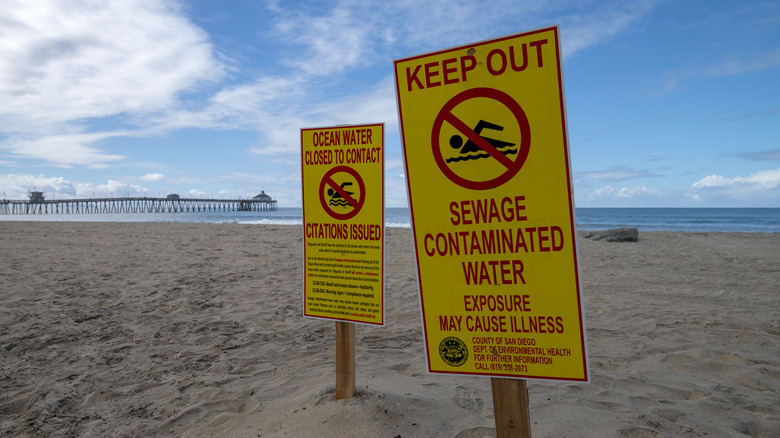This Popular Southern California Beach Is Off-Limits After Test Results Revealed Extreme Levels Of Contamination
It was no surprise to anyone when the Surfrider Foundation's Clean Water Report came out last month, pronouncing Imperial Beach in San Diego as one of the dirtiest waterfronts in the nation. The SoCal shoreline has already been called one of the filthiest in America and has been closed since December 8, 2021, due to sewage contamination from the Tijuana River, which empties into the Pacific just south of Imperial Beach across the Mexican border. The multi-year closure has been viewed as completely unprecedented, but is at least partially out of the U.S.' hands, since the pollution is happening within the jurisdiction of Mexico — a direct result of the skyrocketing population in Tijuana. Often considered a budget-friendly escape from San Diego, the town lacks the infrastructure to support the rising need for additional sewage treatment.
Signs along the coast of Imperial Beach, once a popular Southern California tourist and surfer mecca, warn residents and visitors to "Keep Out of Water." According to The New York Times, testing has found contaminants including arsenic, heavy metals, hepatitis, E. coli, salmonella, and DDT in its waters. But the high levels of contamination have persisted so long at this point that it's not only the water that's unsafe. Airborne toxic chemicals have now been linked to migraines, rashes, and shortness of breath; the city smells like rotten eggs. Imperial Beach's own mayor, Paloma Aguirre, has sealed her windows to keep the fumes out, calling local air quality "extremely detrimental to human health."
What the future holds for Imperial Beach
The transboundary pollution problem between Imperial Beach and Tijuana stretches back as far as the 1930s, when towns like San Ysidro began experiencing tainted drinking water from the Tijuana River. In the 1950s, Imperial Beach noticed pollution in its surf from untreated raw sewage flowing out of the river, and beach "quarantines" came into effect during the end-of-year rainy season, when its runoff intensified. According to the San Diego Coastkeeper's timeline of events, the problem has rapidly worsened since 1997, due to the deterioration of California's own water treatment plant, meant to counter the problem.
President Trump's environmental secretary, Lee Zeldin, visited Imperial Beach for Earth Day in April. He referred to the issue of Tijuana's pollution as "top of mind" for the president as the EPA races to complete a plan of action for the environmental emergency's resolution so that Imperial Beach's waters and air can be clean once again. However, he did emphasize that the solution largely depends on Mexico. "Mexico needs to fulfill its part in cleaning up the contamination that they caused," he told reporters, elaborating that Mexican officials "cannot view this as a U.S. problem just because their contamination reached U.S. soil." In both his and the president's eyes, proper resolution still depends on Mexico committing to cleaning up its waste. For now, consider one of these other things to do in Southern California that don't require swimming in the local waters.

